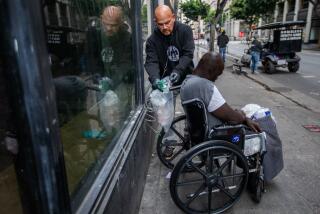Oxygen therapy may speed healing of wounds
- Share via
Remember how Mom always told you to let the air get at your cuts and scrapes so they would heal better? She was right -- to a degree: Air contains oxygen and the more oxygen you provide, the faster and more complete the healing.
But simple removal of a bandage isn’t enough for people with stubborn diabetic ulcers, bedsores, slow-healing stitches or traumatic injuries. And hyperbaric chambers, which expose the entire body to pure oxygen, are expensive, and some people cannot tolerate such high levels of oxygen. Now researchers think they’ve found a happy medium.
They’ve taken advantage of a new and practical way to get extra oxygen just to the affected site. They inflate a clear plastic bag with pure oxygen, stick its edges directly to the healthy skin surrounding the wounds and then secure it around the affected area, creating, in effect, a local oxygen chamber.
The researchers used an FDA-approved device designed for stubborn wounds, and found that it speeds healing. Sores to which oxygen was applied topically healed more quickly and completely than those treated with standard care, which includes surgery, removal of dead skin and sometimes the application of growth factors, synthetic versions of natural chemicals made by the body that encourage new skin to grow atop the wound.
Surgical scientists from Ohio State University tried topical oxygen therapy on 30 patients who together had 56 difficult-to-heal wounds. They applied topical oxygen for 90 minutes on each of four days, then left the wounds untouched for three days. They alternated oxygen treatment and rest for as long as the wounds continued to improve -- from 24 days to about eight months. More than two-thirds of the wounds healed.
When they supplemented oxygen therapy for the toughest wounds with surgery or other wound care, three-quarters of them healed. Moreover, the scarring generally was less than predicted, according to the study in the current issue of the journal Pathophysiology.
The best healing rates occurred in so-called venous stasis ulcers, which occur where blood flow is poor, and diabetic hand ulcers. Bedsores and wounds on the legs and feet were the least responsive to the therapy.
“Topical oxygen is a simple form of therapy which, if necessary, many people could use at once, such as in the case of a public disaster,” said lead author Chandan Sen, director of the Wound Healing Research Program at Ohio State’s surgery department. “These bags are suitable for use in the field, so the treatment may be an option for deployed military troops.”





